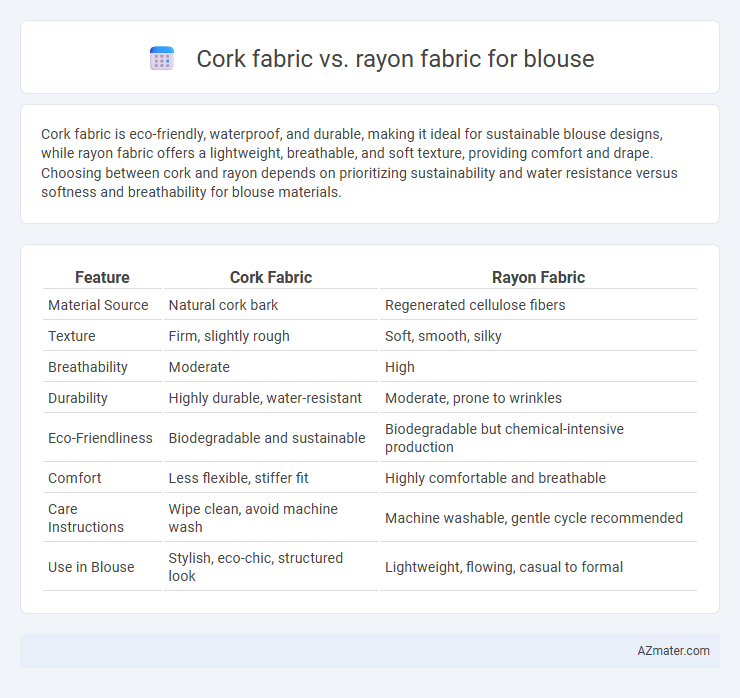Cork fabric is eco-friendly, waterproof, and durable, making it ideal for sustainable blouse designs, while rayon fabric offers a lightweight, breathable, and soft texture, providing comfort and drape. Choosing between cork and rayon depends on prioritizing sustainability and water resistance versus softness and breathability for blouse materials.
Table of Comparison
| Feature | Cork Fabric | Rayon Fabric |
|---|---|---|
| Material Source | Natural cork bark | Regenerated cellulose fibers |
| Texture | Firm, slightly rough | Soft, smooth, silky |
| Breathability | Moderate | High |
| Durability | Highly durable, water-resistant | Moderate, prone to wrinkles |
| Eco-Friendliness | Biodegradable and sustainable | Biodegradable but chemical-intensive production |
| Comfort | Less flexible, stiffer fit | Highly comfortable and breathable |
| Care Instructions | Wipe clean, avoid machine wash | Machine washable, gentle cycle recommended |
| Use in Blouse | Stylish, eco-chic, structured look | Lightweight, flowing, casual to formal |
Introduction to Cork Fabric and Rayon Fabric
Cork fabric, derived from the bark of the cork oak tree, is a sustainable, lightweight, and water-resistant material often used in eco-friendly fashion. Rayon fabric, a semi-synthetic fiber made from regenerated cellulose, offers a smooth texture and excellent breathability, making it popular for lightweight blouses. Both fabrics provide unique properties, with cork fabric emphasizing durability and environmental benefits, while rayon excels in softness and drape.
Origins and Production Processes
Cork fabric, derived from the bark of the cork oak tree primarily found in Mediterranean regions, undergoes a sustainable harvesting process where the bark is carefully stripped without harming the tree, then processed into thin, flexible sheets for textile use. Rayon fabric originates from cellulose, often extracted from wood pulp, which undergoes chemical treatments and spinning to create semi-synthetic fibers commonly produced in textile hubs like China and India. The natural origin and eco-friendly harvesting of cork contrast with the chemically intensive production of rayon, influencing their environmental impact and texture properties in blouse manufacturing.
Sustainability and Environmental Impact
Cork fabric, derived from the bark of cork oak trees, is a renewable and biodegradable material with a low environmental footprint due to its sustainable harvesting process that does not harm the tree. Rayon fabric, although made from natural cellulose fibers like wood pulp, involves chemically intensive processes that contribute to pollution and deforestation, reducing its environmental sustainability. Choosing cork fabric for blouses supports eco-friendly fashion through reduced resource consumption and waste, while rayon's sustainability depends heavily on production practices and sourcing.
Texture and Appearance Comparison
Cork fabric features a unique, natural grain texture that adds an organic, eco-friendly aesthetic to blouses, creating a slightly rigid yet smooth surface with subtle irregularities. Rayon fabric exhibits a soft, silky texture with a smooth finish and excellent drape, offering a lustrous, vibrant appearance ideal for elegant and flowy blouses. While cork fabric provides a distinctive, textured look with matte tones, rayon fabric delivers a sleek, glossy surface with a more consistent, uniform appearance.
Comfort and Breathability for Blouses
Cork fabric offers exceptional breathability and moisture-wicking properties, making it a comfortable choice for blouses in warm climates. Rayon fabric, known for its soft, smooth texture and high absorbency, provides excellent comfort but can trap heat more than cork. Both materials balance comfort and breathability, with cork excelling in airflow and rayon delivering a softer, cooler feel against the skin.
Durability and Maintenance
Cork fabric offers superior durability compared to rayon, resisting wear and tear while maintaining its structure over time, making it ideal for long-lasting blouses. Rayon, although soft and breathable, tends to weaken with frequent washing and prolonged exposure to moisture, requiring delicate care to prevent fabric damage. Maintenance is easier with cork fabric since it is naturally water-resistant and can be wiped clean, whereas rayon demands gentle hand washing or dry cleaning to preserve its texture and prevent shrinking.
Cost and Affordability
Cork fabric is generally more expensive than rayon fabric due to its natural, sustainable harvesting process and durability, making it a premium choice for blouses. Rayon fabric offers greater affordability, thanks to its synthetic production methods and widespread availability, making it ideal for budget-friendly fashion. The cost difference often influences purchasing decisions, with rayon preferred for cost-effective, stylish blouses and cork chosen for eco-conscious, high-end designs.
Style Versatility for Fashion
Cork fabric offers a unique, eco-friendly texture ideal for creating standout blouse designs with a natural aesthetic, suitable for casual and sustainable fashion styles. Rayon fabric provides exceptional drape and softness, enhancing blouse versatility across both casual and formal wear by mimicking silk-like elegance. Both materials enable diverse styling options, with cork fabric appealing to eco-conscious fashion and rayon excelling in fluid, chic wardrobe staples.
Suitability for Various Occasions
Cork fabric offers a unique, eco-friendly option for blouses, excelling in durability and water resistance, making it ideal for casual wear and outdoor events. Rayon fabric provides a soft, breathable texture with excellent drape, perfect for formal occasions and office attire due to its lightweight and elegant appearance. When choosing between the two, cork fabric suits practical, everyday use while rayon fabric complements sophisticated and stylish settings.
Final Verdict: Which Fabric is Better for Blouses?
Cork fabric offers exceptional durability, eco-friendliness, and a unique textured appearance, making it ideal for structured blouses with a sustainable edge. Rayon fabric provides superior softness, breathability, and a fluid drape, resulting in lightweight and comfortable blouses perfect for warmer climates. For blouses prioritizing comfort and elegance, rayon is better suited, while cork fabric excels in durability and environmental benefits.

Infographic: Cork fabric vs Rayon fabric for Blouse
 azmater.com
azmater.com